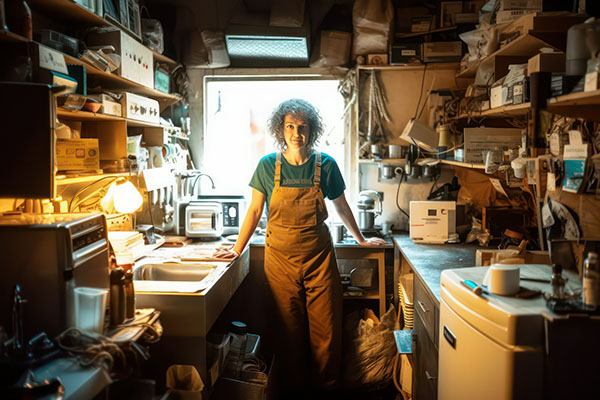Prepping for Grid Collapse with Iron-Nickel Batteries
by J. G. Martinez D., The Organic Prepper:

Due to the actual collapse of the Venezuelan grid, I have put together this article, entirely from the survivalist/prepper point of view. I will discuss different types of batteries you can use if the grid goes down, including my favorite, iron-nickel batteries.
Here’s how batteries work
To understand how batteries work, I will start from the beginning. All kind of materials are constituted of atoms: an atom is formed by a nucleus with electrons orbiting around, at light speeds, and that makes a sort of a cloud, so fast that the atoms seem to be “solid”. Different materials have a different number of particles in their nucleus, and the shape, size, and orientation of their electronic “clouds” are different. The number of electrons forming this cloud is variable for each material as well. But the electrons can travel freely through the metallic materials, much better than in other materials, and their movement generates what we called electricity.
And we use this energy to light bulbs and lots of other useful activities.
In all kinds of batteries, the electrolyte is the media for the current to flow between the materials, internally. The specifications are very important for us: density, level, composition, all of this must be in the proper range so our battery works flawlessly.
There are metallic materials where this movement of the electrons is more efficient, indeed. Therefore, a variety of materials are used: nickel and iron, or lithium, phosphorus and lots of other different combinations. The objective is to provide the most efficient combination.
Here is where the merchandising comes into stage. Manufacturers love to use exotic materials for batteries. Obviously, they have done extensive research on materials, in order to produce to an industrial level, an optimized combination of power, durability, and reliability. Of course, many of us are not just willing to use sulfuric acid or some other similar chemical in our cellphones batteries.
The 101 of batteries, is, that whenever you make contact between two different metals, an electric current will be generated, as the electrons travel from the states, or orbits, of more energy to those of less energy; this is a natural phenomenon that usually does not require any energy activation except in some very special instances. Nature tries to balance the electronic charges in the mixture, in order to look for an equilibrium point. They will travel throughout any media that can conduct electric current; this can be liquid or gel. It is called electrolyte, in a battery. The good part is, that we use the energy of this search of such point to light bulbs and lots of other useful activities.
As the electrolyte is the media for the current to flow between the materials of the battery, the electron “donor” and the other one receiving the electrons, the specifications are very important for us: density, level, composition, all of this must be in the proper range so our battery works flawlessly.
There are metallic materials where this movement of the electrons is more efficient, indeed. Therefore, a variety of materials are used: nickel and iron, or lithium, phosphorus and lots of other different combinations. The objective is to provide the most efficient combination.
Nickel-iron batteries have special qualities.
Here is where the merchandising comes into the stage. Manufacturers love to use exotic materials for batteries. Obviously, they have done extensive research on materials, in order to produce to an industrial level, an optimized combination of power, durability, and reliability. Of course, many of us are not just willing to use sulfuric acid or some other similar chemical in our cellphones batteries. But these are intended to be used in a lifecycle close to two or three years. But these are intended to be used in a lifecycle close to two or three years, just as car batteries, so lead can be recycled to make new sponge lead for another battery.
As contaminant as it is, its low price and properties for electrical applications make it suitable, because it is easier to work with it: it’s soft, melts at low temperature, etc. This means advantages for the manufacturer. Not so much for the owner, as we all can see new: we have to buy a new battery for our car every year if we want to keep it running.
Nickel-iron batteries have been known to have a lifespan of over 50 years. That is one of their main attractions for preppers. Some commercial brands offer 10 years of warranty, and that is pretty much acceptable in my standards. Chemicals used are much less hazardous than those used in lead batteries. And less expensive, I think.
Therefore, in many applications, these batteries are not going to be used just because they last too long. This is not good for the manufacturer that expects continuous growth in sales. The expectation of the corporative executives is that the company should expand and grow; for them, the sky is the limit, even though, the planet remains the same size and the mankind keeps piling up.
Perhaps for some people weight is a concern, or some other feature could be a disadvantage. Yes, they are heavy but lead acid batteries are too. And another good feature that makes me like them, is that they don’t generate fumes emission. At least not the corrosive fume kind: lead acid batteries produce hydrogen, highly explosive and flammable gas that needs to be vented. For those of you who never heard or saw a lead acid battery exploding while charging, it is nasty. There is acid sprinkled all over the place, a very wise reason to charge the batteries in a safe and far away place.
The ability to use a car type charger is another plus. Therefore, these present several advantages over regular lead acid batteries, being the long life one of those that like me the most. The materials used in batteries is not just a bar, it is more like a sponge, to maximize the contact with the electrolyte and get all those electrons traveling between the metal plates. If you are environmentally aware, some heavy metals such as cadmium are harmful and toxic. Perhaps their performance is outstanding, but their lifespan is not close to that of the nickel-iron ones. There are even some home-made examples around with good results. With the wide amount of materials available, I believe that with some ingenuity it could be done by those with technical skills and some basic knowledge on electrochemistry. The original Edison battery has been modified, and their disadvantages have been overcome. Iron and nickel are plentiful, too. It would be much easier in the future to use low tech methods in order to repair or rebuild one of these devices. They don’t need cutting edge technology to be manufactured.
There are some differences with other technologies: the energy density is not as high as other types of batteries. This was the main reason to abandon them as sources for electric cars in the 70s. However, their advantages allow me to think that they would have been a wonderful addition to my equipment. Of course, conveniently disguised in an RV. I have thought about the placement of the batteries array, and now I believe it is pretty convenient to install them flat, with the longer side against the wall, one next to the other, and in both sides of the camper, high enough, and perhaps behind the cabinets. The reason? Weight balancing, in the first place. Keep reading to understand why.
Protecting your iron-nickel batteries
Upon seeing some recent news, I have come to ask myself plenty of questions about the nature of events that could involve us, regardless if it is here or in some other place. I watched some alarming videos a few weeks ago, where heavy rain filled some streets in Caracas and some other cities in Venezuela and could see how big a disaster could be to try to circulate in such climate with a large camper truck.
Therefore, batteries should not be in a compartment close to the ground in any way. The truck should have a large clearance, and the structure of the camper itself must be sturdy and robust. I was not particularly a fan of this, but after watching those floods (and some of them very close) I realize now that it is going to be a need. The truck must be waterproofed, and the engine too: snorkel, water protection, zero electronics. Diesel, if I can get my paws in enough cash. There exist some check-type valves for the transmission fumes vents, so water does not come into the gearbox. Off roads guys know a lot about this.
How many batteries do you need?
Regarding the batteries, there are some deals offering some units volts 1.2, with a 1000 Ah capacity. Ten of these units will give you 12 volts. Whether this is or not suited to the needs, it is something that I will try to elucidate in the next few paragraphs. Of course, I will use our own values, based on what is average in most of the Venezuelan medium class homes: laundry machine, microwave (not often), a couple of air conditioners, a refrigerator, the usual blender, a couple of TVs and lighting.
With the kind of sun in Venezuela we don’t use much power for dryers. I have never understood why so many people love to shower with electric core heaters showers. I love cold water. If you have some resources, build or procure yourself a solar heater.
Why I trust so much in this combination of metal for batteries?
Because I am a metallurgist. Maybe there are some other setups that work for the industry based on their features: lightweight, dry electrolyte, meaning no spills of potentially hazardous chemicals and similar stuff. But for me, provided that the first batteries created are still working with the same performance, it says a lot. Lithium-ion batteries are now the thing because of the features I mentioned.
But if you have a homestead that is going to be there a long time…I would invest in a good setup of this for my rack. I will do it, as a matter of fact. No hard-to-find chemicals to replace, other than the solution used as an electrolyte, the materials used are plentiful and abundant, meaning that with some more research in the near future could lead to good improvements in this technology. I have checked some websites and the general consensus in them are that Iron Nickel batteries need lots of maintenance, and are not recommended for solar arrangements because of the amortization cost on time.
Of course, if you are in the top of a mountain without access to the grid, or simply don’t want to deal (because perhaps you don’t even need to depend on an external energy source) with the problems that paying a monthly bill brings along, then the best decision would be to use the much cheaper lead-acid options available. But…what will happen if you don’t have access to replace those racks in the future if something happens?
Read More @ TheOrganicPrepper.ca
Loading...



